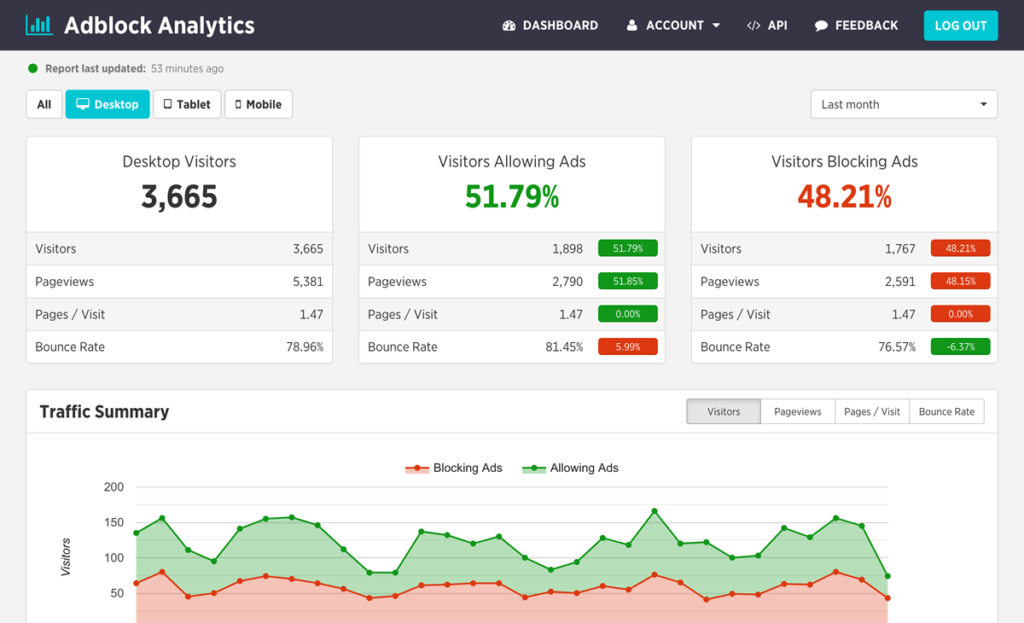Ah, the internet – a boundless digital frontier where everything you want to know is just a click away. Yet, it’s also a landscape dotted with countless digital billboards: pop-ups, banners, tracker, and those ghastly auto-play videos that rudely interrupt your tranquil reading session. Traversing this terrain can feel like sprinting through a gauntlet of online ads.
Enter ad blockers – our digital knight-errants that rescue our browsing sessions from the incessant onslaught of ads and trackers. As cherished as they might be by the digital explorers (and, to be fully transparent, I use an ad blocker is certain contexts), their reception isn’t as warm amongst marketers and analysts. So, let’s delve into the intricacies of ad blockers: what they are, how they operate, and the ripple effects they cause in the world of digital marketing.
Guardians of Your Online Experience
At their core, ad blockers are software programs crafted to keep ads at bay while you traverse the internet. They achieve this by spotting and obstructing the code that displays these ads on a webpage. Their strategy? They maintain a list of known ad-serving domains and block any requests that your web browser makes to these domains. Think of them as the bouncers at a club, deciding who gets access and who gets the boot.

Here’s a brief of how it unfolds. As you land on a webpage, your browser sends a request to the server hosting that page for the HTML code that forms it. The server reciprocates by sending back this code, which your browser then processes and exhibits as the webpage you see.
If the HTML code includes ads, your browser will send additional requests to the ad servers for that content. This is where ad blockers come into play – they intercept these requests, preventing them from reaching the ad server, and effectively banishing the ad from your screen.
It’s like having a personal digital assistant, batting away those pesky ads before they ever reach your sight. Let’s take a look at the figure ways ad blockers are made available to users:
Browser Extensions
The most common form, they’re easily installed as add-ons or extensions to a web browser. They operate within the browser to filter content and block ads on the webpages you visit. They’re simple to install and configure, and some allow non-intrusive ads and whitelist content creators of your choosing.
Browsers
Privacy technologies are now integrated into the browsers we use. Privacy-focused browsers like Brave have an inherent ad blocking system. Others, like Firefox and Safari, have introduced technologies that impede data collection, like Safari’s Intelligent Tracking Prevention.
Standalone Applications
Some ad blockers function as standalone applications that you install on your computer. These applications block ads across all browsers and other applications that display ads. Pi-hole and VPNs like Surfshark are examples of this type of ad blocker (while they also serve additional functions outside of blocking ads), intercepting and blocking ad requests at the network level.
Who Uses Ad Blockers?
Now that we’ve covered the what and the how, let’s look at the who. So, who exactly is using these ad blockers? At the time of writing (2023, if you can believe it), 42.7% of people use ad blocking software. This figure has been on a steady rise from 15.7% in 2014 to 27% in 2022. It seems that the general public’s distaste for ads has not waned over the years. The data also indicates that ad blockers are used more on personal computers (37%) compared to mobile devices (15%) and tablets (10%).

When breaking it down by age, we see that 60% of individuals aged 18 to 24 were using ad blockers on desktops and laptops, with 18% of this age group using ad blockers on smartphones. For those between 25 and 34, 47% used ad blockers on their desktops and laptops, with 34% using this technology on their smartphones. Lastly, 51% of ad block users aged 35 to 54 used this kind of software on their desktops and laptops, with 35% using ad blockers on their smartphones.
The Blocker Effect: Marketing and Tracking
Now, while ad blockers might seem like a blessing to the average internet user, they pose significant challenges for the online advertising industry. By blocking ads, these tools reduce the number of impressions and clicks ads receive, which, in turn, can slash the revenue that advertisers generate from their campaigns.
Not surprisingly, this has sparked some tension between ad blocker developers and the advertising industry, with some advertisers and publishers even attempting to block or limit the use of ad blockers on their websites. But the impact of ad blockers extends beyond advertisements. They can also affect tracking tools like Google Analytics and Facebook Ads, both of which rely on small pieces of code embedded in a webpage’s HTML to track and analyze web traffic.
Google Analytics, for instance, inserts a tracking code into a webpage. This code sends data back to Google Analytics whenever a user visits the page (or undertake an action that is tracked by a publisher), allowing the website owner to track metrics like page views, session duration, and more. However, if an ad blocker is blocking requests for ad content, it may also block requests for this tracking code. This can skew the accuracy of the data collected by Google Analytics, potentially impacting a web publisher’s ability to make informed, data-driven decisions.
The exact percentage of data lost due to ad blocking can vary depending on bunch factors, such as the demographic composition of the website, the prevalence of ad blockers among that audience (adult content and privacy blogs may have a higher number of users who are blocking ads and trackers), and the type of content displayed on the website.
Now, you might be thinking, “Well, if ad blockers are causing so much trouble for marketers, why not just find a way around them?” It’s a logical question, but the answer isn’t so simple. Yes, there are technical ways to circumvent ad blockers (server side tagging for one), but the ethics of doing so are a bit murky.
Think about it this way: People install ad blockers because they don’t want to see ads. They want a cleaner, less cluttered online experience. Moreover, there’s also the fact that digital advertising isn’t always the most ethical practice. There are issues with privacy, with data collection, and the opaque nature of it – it’s hard for an average web user to know what data is even being collected. People have valid reasons for wanting to block ads, and we have to respect that.
How To Manage Data Loss
Now, let’s address the burning question: how many of our visitors are using ad blockers? As you likely know, I’m a hardcore believer of transparency and consent when it comes to data collection (if not most things in life), so let’s explore privacy-conscious methods to uncover this information and how you can overcome it:
Understand Your Data Gap
The first step here is to understand how much data it is you are actually missing out on. But how do you measure something that isn’t even there? This sounds like a question that one of those university lectures who casually drops the benefits of LSD into conversations. Thankfully, there are a number of solutions that don’t require the use of any hallucinations.
Now, the most ethical way to measure adblocker usage is to keep as much of your solution in a first-party context as possible. This means that you are not replying on external sources for measuring and storing the data where possible. Now I get it – it’s not always possible of feasible to set up a completely first-party solution, and thankfully you don’t need to.
There are services such as Detect AdBlock which allow the mechanisms for, well, detecting the use of ad block. In fact, they also offer a full analytics suite for aggregating data and generating reports.

You can also survey your users to understand how many are using ad blockers, although, the reliability of this kind of data can be questionable as you might end up with biases in your data that misrepresent the actual numbers; for instance, ad block users might be less likely to participate.
Whatever solution you use for detecting and storing data about ad block usage, keep in mind that people need to have their privacy rights respected, even if your solution is completely first-party. And if you are using third-party services for detection or storage, you need to consider how this might impact a user’s privacy.
Lost and Found: Backfill Your Data
Once you have an understanding if your data loss gap, you can start work on backfilling your data in your reports, either though data sampling or query-time calculations (adding modifications to your data outputs in PowerBI, Tableau, or LookerStudio). Once again, me mindful that the users who use ad block might have a very different demographic and behavioral signature to your other user segments.
Now, I actually have some good news and it relates to Google Analytics 4 (GA4), if you can believe it. GA4 uses machine learning to backfill lost or incomplete data for us, so we can get some degree of recovery here which, unlike Universal Analytics, would require manual intervention and data processing, like what we spoke about above.
Dear Jon: Take Me Back
The next step here is to see if any of your users would be open to adding your site to their ad block allow list. The key here is not sounding like that crazy ex who is desperate to have you move back in because “nobody brews tea just like you do”. It’s crucial to keep a close eye how people respond to this activity and adjust your approach accordingly.
Keep It Short and Relatable
Keep your message short and sweet. Avoid lengthy explanations and provide information in a clear and succinct manner. People want to tick and flick, and get back to looking at guineapig pictures, or whatever it is that they were doing on your site. Connect with your audience on a personal level without being too generic or, on the end of the scale, creepy. Use language that is relatable and authentic.
Be Transparent
Let’s be real, most people have no idea how ads or web analytics support the creators and sites that they love. Demonstrate honesty and transparency when explaining the role of ads in supporting your site or organization. Emphasize the value they bring by enabling the creation of high-quality content or supporting your team, and how that benefits them as the end user. This helps visitors understand the significance of allowing ads.
Avoid Technical Jargon
Utilizing a synergistic amalgamation of quantum entanglement-driven neural networks, the intricate dynamics of multi-layered tensorial transformations effectuate optimal AI convergence.
Need I say more?
Final Thoughts
In the end, it’s all about striking a balance. As internet users, we all desire an ad-free browsing experience. As marketers and content creators, we understand the necessity of ads for sustaining the free web content we enjoy daily. It’s a bit of a digital dance that we all participate in, and it’s up to us to find the rhythm.
Ad blockers aren’t going anywhere anytime soon, and it’s crucial for us to adapt to this reality. Understanding ad blocker usage and its impact on our data is the first step. It’s about open communication, transparency, and the respect for individual privacy that will help bridge the gap between user experience and the necessity for ad revenue.
So, as you navigate your way through the digital world, remember to consider the impact ad blockers may have on the content you enjoy. And if you’re a content creator or a marketer, take the time to understand your audience and their preferences. After all, the internet is a shared space, and it’s up to us to make it an enjoyable one for everyone.

